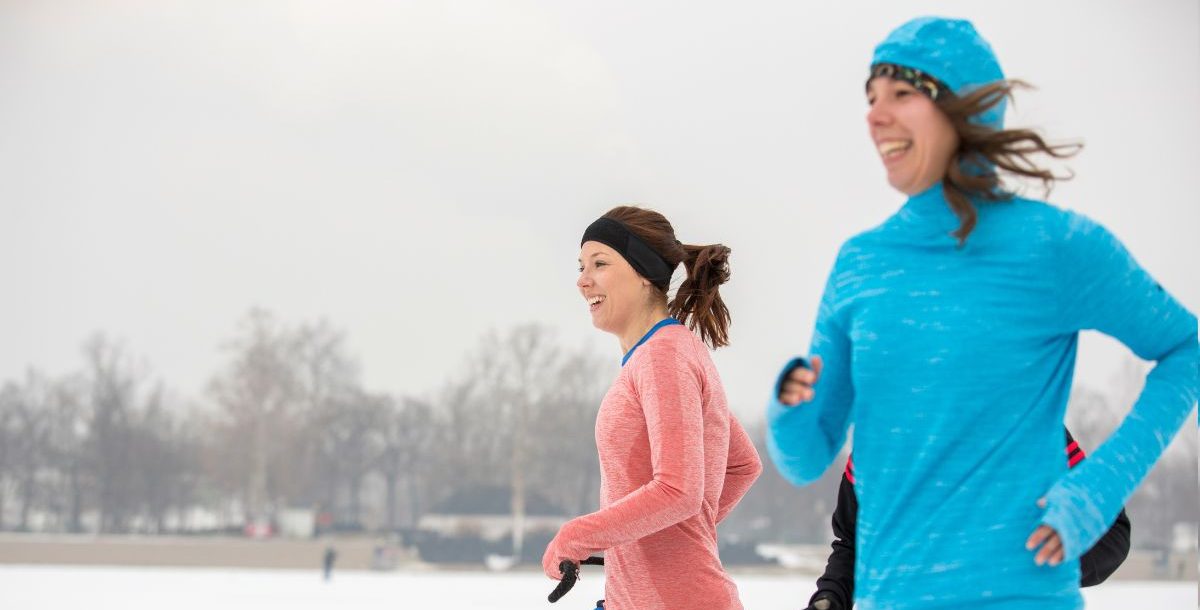Running in the cold can be an invigorating way to stay active during winter. It offers unique benefits, but you’ll need to approach it with some extra preparation. Here’s a guide to making the most of cold weather running while staying safe and warm (enough).
Why run in cold weather?
It’s definitely easier to stick to exercising indoors when the temperatures drop. But maybe you don’t have the space or belong to a gym. Perhaps the treadmill doesn’t work for you.
However, there are some great benefits to running in cold temperatures. These include:
- Cardio boost: Cold weather running is a fantastic way to meet your weekly fitness goals while exercising your cardiovascular system.
- Burn more calories: Cooler temps can activate brown fat, which helps burn more calories to keep your body warm.
How cold is too cold?
While you can plan for cold weather running, at some point, it might be too cold. As long as you’re healthy and prepared, it’s generally safe to run in temperatures as low as 0 degrees Fahrenheit.
However, the game-changer is the wind chill. If it’s 25 degrees outside, but there’s a strong breeze and clouds blocking the sun, it’s going to feel much colder. Once you dip into extreme cold, the negatives begin to outweigh the positives.
What to wear for a run in the cold
When it comes to dressing for your winter run, it’s all about layers. However, not all layers are alike or serve the same purpose. A good starting point is the three-layer approach:
- Base: This layer is directly on your skin. To keep moisture off, wear a sweat-wicking synthetic material or merino wool.
- Middle: The main purpose of this layer is insulation. Here’s where you can adjust the most depending on the weather. Wool or fleece long-sleeved shirts are the most effective way to trap body heat.
- Outer: This protects you from the elements. A wind- and water-resistant running jacket as an outer layer keeps your inner layers dry and blocks out the wind.
But don’t forget that your extremities – hands, feet, ears and even your face – get cold fast and are the first to get cold when your body redirects blood flow to your body’s core. Make sure you also wear:
- Moisture-wicking gloves or mittens
- Thermal (not cotton) socks – your running shoes won’t keep your toes warm or dry
- A headband or hat that covers your ears
- A gaiter or other type of scarf to cover your face when it’s really cold
More cold weather running tips
Running in the cold requires more than just wearing the right clothes. Taking precautions also helps to ensure you get through your workout safely.
Warm up indoors
Don’t skip your warm-up! Do some dynamic exercises like jumping jacks or walking lunges inside before heading out. It’ll get your muscles ready and reduce your injury risk.
Don’t forget water
Just because it’s cold doesn’t mean you won’t sweat! In fact, it’s more difficult to notice dehydration cues when you’re cold. You might not feel as thirsty, you lose more fluid through breathing, and your body doesn’t tell you it needs water the same way it does in the cold. Stay hydrated by drinking water before, during and after your run.
Stay visible
Winter means shorter days and less daylight. Make sure you wear bright or reflective clothing to be visible to drivers and other runners.
Check the weather
Always check the forecast before heading out. Wind chills and icy conditions can make a big difference in your safety and comfort. If the conditions are extreme, consider rescheduling or opting for the treadmill.
Know the warning signs
Learn to recognize early signs of frostbite (numbness, tingling) and hypothermia (shivering, slurred speech, fatigue). If you notice any of these, head indoors and warm up immediately.
Ease into your run
Cold muscles are more prone to injury, so start your runs at a slower pace and gradually increase intensity.
Let someone know
Always let a friend or family member know your route and when you expect to return. It’s a simple way to stay safe, especially on quieter trails.
After your run
Running safely in the cold doesn’t end when you stop your watch. Having a post-run routine is even more critical in colder weather. When your run is over, make sure to:
- Do a cool-down
- Change into dry clothes right away
- Eat a nutritious meal
- Drink something warm
How we can help
Cold weather running doesn’t have to be a winter punishment – you can still maintain your fitness and likely even improve it. Everyone responds differently to cold conditions, so pay attention to how your body feels.
However, accidents and mistakes happen. If you get hurt on a run or feel unwell after, make an appointment with a provider or visit an urgent care near you.
Learn about the orthopedics and sports medicine services we offer at Mercy Health.






